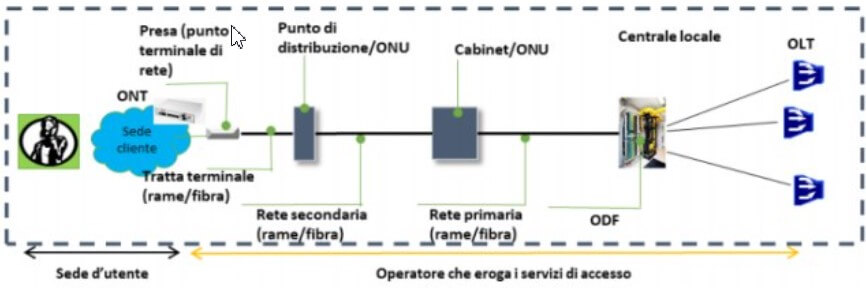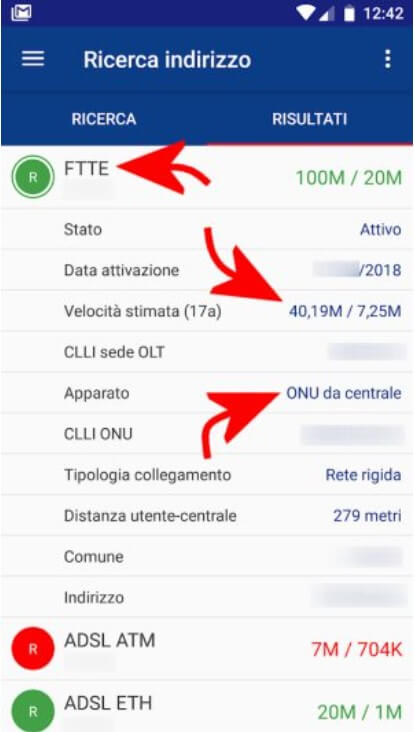What is the meaning of FTTE fiber: can it be a step forward compared to ADSL? Let’s see what it is and how it works.
Several of our readers have reported to us that for some time now, in many places in Italy, users that until yesterday could activate ADSL connectivity up to 20 Mbps on an elastic network today may require the activation of an FTTE ( Fiber To The Exchange ) on a rigid mesh.
In the article Rigid network: what it is and why the connection performance is lower, we have seen that the rigid network scheme is sometimes used to connect users located near the control panel directly to the equipment in the control unit. Compared to the elastic network, the rigid network is characterized by the absence of intermediate terminations between the switch and the distributor.
As is known, in FTTC ( Fiber-to-the-Cabinet ) connections, the fiber is brought up to the street cabinet, generally placed within a radius of about 300 meters from the building to be served. Subsequently, the traditional copper cable or “twisted pair” is used from the street cabinet to the subscriber’s modem router.
Unlike the FTTH offers, the fiber connection therefore only reaches the street cabinet, so much so that FTTC connectivity services can be marketed by clarifying that the network architecture is ” mixed fiber-copper ” (yellow stamp).

In the FTTE fiber case, the fiber optic connection reaches the control unit and does not even continue as far as the street cabinets. For this reason, this type of connection is described with the red ” copper ” stamp in the pre-contractual and contractual phase.
FTTE: what is the point of activating this type of connectivity if the network always remains the same?
In line distribution cabinets served with fiber (FTTC scheme), the ONU Cab (MiniDSLAM VDSL2; ONU stands for Optical Network Unit ) is installed on top. In some locations where the secondary network needs further updates, TIM has deemed it appropriate to bring at least FTTE connectivity.
Until yesterday, more and more locations were only covered with ADSL connectivity up to 20 Mbps on an elastic network are being reached (also) by FTTE connectivity on a rigid network.
Also, how easy it is to check using a great tool like Fibrapp for Android, FTTE connectivity increasingly seems to be brought from a different control unit than the physically closest one is sometimes located 5-6 kilometers away.
Many readers have asked us the point of activating an FTTE connection if the optical fiber reaches the control unit and not up to the single street cabinet .
The advantages exist and are connected to the higher data transfer speed obtained with FTTE on a rigid network compared to a normal 20 Mbps ADSL .
As we have seen in the article From ADSL to fiber: what changes and what VDSL and vectoring mean , FTTE connectivity allows us to use the VDSL2 technology, which allows us to considerably improve the spectral allocation compared to ADSL2 / ADSL2 + by exploiting a wider frequency spectrum.
While in the case of FTTC, it is possible to transfer in the downstream data rates up to 200 Mbps in case its user was attested on a compatible street cabinet, using a modem router capable of supporting the 35b profile and reduced distances from the cabinet (EVDSL2 support, Enhanced VDSL; see What is profile 35b for FTTC optical fiber and how it works ), in the FTTE case the theoretically obtainable maximum data transfer rate is 100 Mbps (profile 35b is not used).
The speed obtainable in practice will, however, be directly influenced by multiple factors such as the distance from the control unit and the presence of noise on the transmission medium (between the user’s modem router and the ONU in the control unit):SNR: what it is, how to increase it and why it is lowered on ADSL and VDSL.
For some time now, the TIM tool for checking coverage has offered more information on the connectivity services available and the fiber-optic network architecture.

In the image, the example of a user who can activate FTTE connectivity: the estimated downstream and upstream values show how the assumed performance can be significantly higher than a traditional ADSL.
In addition to the best downstream performance, it is possible to obtain upstream performances that are highly interesting, especially if you often upload content to remote servers (think of backup on cloud storage services, uploading videos, sharing projects of dimensions important, …). A nice leap forward compared to that single Megabit in upload that in the best cases is obtained with a 20 Mbps ADSL: see Mbps what does it mean and what does it correspond to?
Switching to FTTE will also make it possible to reduce latency below 20 ms, a value that can never be achieved with traditional ADSL.
TIM’s estimates can also be crossed with the excellent Fibrapp, one of the best tools to check which services can be activated at each house.
As can be seen, the value returned by Fibrapp is absolutely in line with that provided by the TIM coverage verification tool.
Fibrapp is also very useful for gathering information on TIM’s planned coverage. It is much more immediate and easier to consult than the spreadsheets published on the Telecom Engish Wholesale site.
We asked TIM if the users with FTTE service on a rigid network will likely be switched to FTTC in the future (possibly also profile 35b) if possible to obtain an updated schedule regarding FTTE coverage. Wholesale service is offered to third party operators also regarding FTTE.
TIM replied that in the spreadsheets published at this address (“geographic coverage of the Bitstream NGA and VULA services”) and in particular in those relating to the cabinet areas (both active and planned), the UN is indicated with the UN type column in which figure UN from central.
Through these ONUs, VDSL accesses in FTTE technology are provided to Operators who request it. The expected opening date is shown in the cover files relating to the planned cabinet areas for each UN from the exchange.
If both ADSL (for example, bitstream ADSL up to 20 Mbps ) and VDSL FTTE, the service’s choice to be activated depends on the order sent by the Operator.

A tech-savvy writer with a knack for finding the latest technology in the market, this is what describes John Carter. With more than 8 years of experience as a journalist, John graduated as an engineer and ventured soon into the world of online journalism. His interest includes gadget reviews, decoding OS errors, hunting information on the latest technology, and so on.













